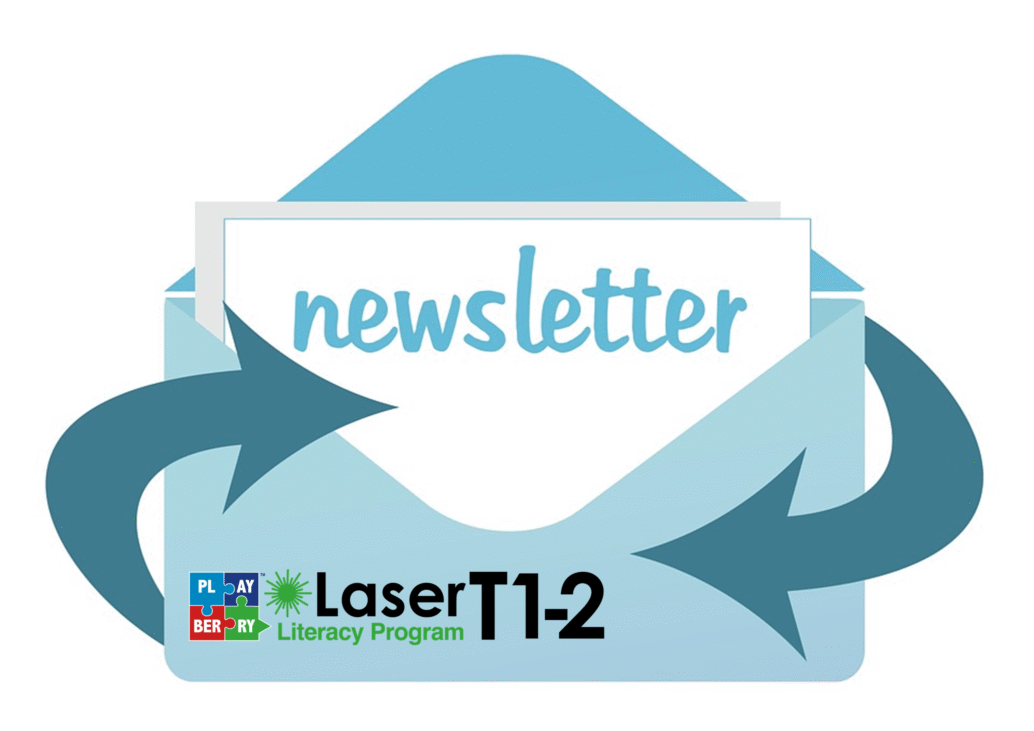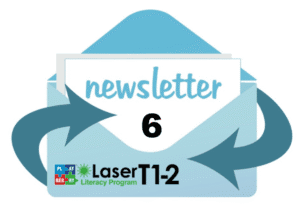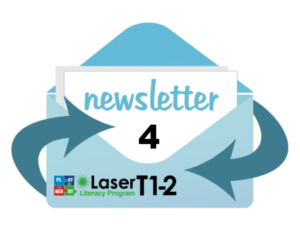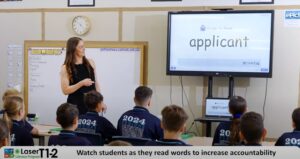The Playberry Laser team hopes you are well and that your colleagues and students are settling into term 3.
At Playberry Laser, we are always thinking of ways to help you improve your structured literacy teaching. This means we will occasionally add to or change the platform; this newsletter will keep you updated. We’ll also write pieces on teaching methodology and research occasionally.
In addition, we will point you to parts of the Playberry-Laser platform that you might not have seen, as well as our blog posts on different topics.
Additive Blending in Phase 1 Words to Read
Additive (successive) blending is an effective scaffold for early or struggling readers. With this blending, the teacher and students blend one sound at a time as they work their way through the word. On a page, the teacher controls the rate at which new letters appear by covering letters. On screen we have set up animations for this. Teachers can click back and forward through the word as necessary. All graphemes appear individually in the early weeks, but later, different consonant blends cluster into larger orthographic units.



The teacher can use additive blending or quickly click through the word without blending with students. We look forward to hearing what teachers think of this new feature.

Teaching Heart Words Well
Irregular words are about 30-40% of English words with one or more letters that don’t follow standard grapheme-phoneme correspondence patterns (GPCs). Many programs call these words ‘heart words’ because a speller has to know parts of these words ‘by heart’. Only about 4% of words are truly irregular and defy all explanations. The rest of them may only have one or two irregular GPCs.
Some students store heart words easily after just a few spellings. Most students need multiple practices with spelling, following a routine of saying the word, spelling it aloud with letter names (not sounds – please, not sounds) and then writing the word on a mini-whiteboard for the teacher to check. The routine we teach in Playberry-Laser is the ‘Superman’ arm. This routine connects Kinaestethic to Visual and Auditory (VAK) mental representations, making it a multisensory routine. To see this routine done correctly, check out the Demo Lessons. The teacher manual also explains the correct routine step-by-step.
Don’t stress, but DO teach heart words thoroughly!
Word recognition always comes before accurate and reliable spelling when it comes to heart words. In other words, students will be reading heart words long before they can spell them reliably. That’s just how it goes. Students will never master some heart words! I still struggle to spell ‘bureau’.
A typical student won’t master every heart word in our scope and sequence, and they don’t have to be able to be proficient spellers. Our scope and sequence far surpass the ACARA standards. If any student does master the entire list, get them enrolled in the first spelling bee you can find!
We don’t want teachers or students worrying about heart word assessment results. All you can control is teaching them correctly, and this is where we see things go astray. Here are common errors we see:
- Students who are NOT doing the multisensory Superman arm routine correctly (and teachers letting them off!)
- Teachers do not teach the new heart word; rather, they go straight to the Superman arm routine (again, see demo lesson videos and teacher manual for the correct teaching routine for new heart words).
- After doing the Superman arm routine, students do not write the word on their boards or in books.
Get the word ‘in the hand’ after it’s Supermanned!
- Students say sounds and not letter names. Sounds don’t help with the irregular parts of heart words. That’s what makes them heart words!
Heart Words have historical explanations for their irregularities.
The cool thing about Heart Words is that they’re not haphazard! Every oddly placed letter has a reason, and kids love the stories that surround the spellings of words. They love telling their parents/caregivers, too! If you’re a word nerd like us, Sue Scibetta’s wonderful book Beneath the Surface of Words is an incredible read for more information about how all sorts of words came to be spelt how they are.
A favourite story of mine is how the ‘w’ made its way into ‘answer’. It belongs to the old English word answers, which means a response or a reply. Andswaru meant “a sworn statement against” or “a reply.” In olden times, if a person was in the court of the land and was giving an answer, they had to swear that they were telling the truth. If you know the story, you know where the ‘w’ should go and why it’s there.
Now, we definitely don’t want you stopping a phonology lesson to tell the story of a heart word; you’ll lose lesson flow. Do, however, tell the story another time. Fire up The Word Cracker Online or go to Etymonline to do some sleuthing as to how those strange letters got into a heart word.
Spelling Voice – something strong spellers have but rarely mention!
Ensure students know ‘spelling voice’ when spelling heart words. When I spell ‘heart’, I mentally say he – art, (he loves art) which helps me remember the letter ‘e’. I bet you have a trick of your own for Wednesday! This will be more difficult for students with phonological deficits like dyslexia.
Bringing Heart Words to Life outside of Phonology lessons
Here are a few ideas to use outside of Playberry-Laser lessons to give students more practice with heart words:
- Choose a heart word as an attentional call and response cue and use it for a week. When you want the class to stop and listen, call “heart word … ‘answer'”. Students then respond with the Superman routine for answer.
- Do stop and spell heart Superman arm routines as energizers – when things are a little flat, call out “stop and spell … ‘height'”. Students stop what they’re doing and do the Superman arm routine, then write the word on a mini-whiteboard (if it’s within reach) or in the margin of a book they’re writing in. Randomly draw two or three students’ names, check their spelling, and award a point for whether it is spelt correctly or attempted and corrected.
- Cold-call a table or pair of students to recall the spelling of a heart word. Give them a brief moment of deliberation, and award a point if they can spell it correctly aloud. If not, ask another pair to rescue them, and both teams get a point if the rescue is successful. If both pairs cannot recall the spelling, you know to rehearse that word more with the entire class.
- Run an ongoing heart word spelling competition where weaker and stronger spellers are teamed together.

SAVE THE DATES Week 0 2025 Training dates
21st Jan – The Evidence-Based Teaching of Reading and Spelling Kickstarter (optional)
Educators need a well-articulated case for changing how and what they teach. Bill carefully and sensitively builds a context for the Science of Reading, explains its long history and deep, convergent evidence base, and makes sense of the essential elements of evidence-based teaching to come. Click here for more information on the contents of this training day.
22nd Jan – Training Day 2: Phonology Nuts and Bolts (Compulsory Tier 1 Training)
This full day is about what to teach and how to get teachers started in their classrooms. We cover spelling rules and conventions, syllable types, lesson content, lesson structure, explicit teaching methodology, review routines, and assessment.
BOOKING INFORMATION COMING SOON
Can your school provide us with a venue for week 0 training?
We’re looking for venues for the above week 0 training days. Thank you to St John the Baptist (Plympton), who hosted us this year.
If you have a large space that isn’t being used on the 21st and 22nd of January 2025 and can offer it, please email Bill at bill@hansberryec.com.au. Any participants from your site will be able to attend the training(s) at no cost.

Phase 0 has lift-off!
Phase 0 has kicked off for mid-year reception intake. Phase 0 had a long testing process in a number of schools. Thanks to those teachers who gave it a test run for us.
The goals of phase 0 are to:
- Focus on Phonological Awareness and Alphabet naming (both highly predictive of reading success)
- Establish routines used in lessons
- Teach some initial code, which will be covered again in Phase 1.
- Teach concepts of print through read-alouds
You can see the Phase 0 scope and sequence here.
To have a look at the Phase 0 resources, go to the resources section and select ‘Phase 0’ from the pull-down search menu.
Lesson Videos to learn from

There’s no better way to check your teaching than to watch an expert! So far, we have lessons up for:
Phase 3: Christie Lee Hansberry with a year 4 class
Phase 2: Sarah Battistella with a year 1 class
Phase 3: Christie Lee Hansberry (Catch Up Morphology) with a year 5 class
Tier 2 Intervention: Linda Clune
Tier 2 Intervention: Bill Hansberry
Phase 1: Jared Centenera with his Reception class
Each lesson has a downloadable teacher notes page so you can follow. Each video also includes extensive Masterclass Notes, which take you through every moment of the lesson, step-by-step, explaining the little pieces of the teaching that are deliberate and powerful but easily missed unless pointed out. More teaching videos are on their way.
We have a how-to section!

Where’s the teacher manual? What if I want to map Playberry Laser to the Australian Curriculum or give an enquiring parent some information that explains why our lessons look the way they do? Where do those Teacher Tips that Bill puts on his Facebook go? All this and more are in the ‘How To’ section.

Website Outages
Last term, there were some website outages. These were teething problems caused by us changing servers from a shared server to one exclusive to Playberry Laser. We think we’ve sorted this out now.
If you experience an outage, Can one person from your school please contact us with the time and date of the outage and let us know when it goes live again? This helps us diagnose the issues.
We apologise for the inconvenience.
Multiple failed login attempts might get your school booted from the platform!
Recently, a few schools temporarily lost access to the platform because one teacher forgot their login and tried to log in with incorrect credentials several times. When this happens, our website anti-hacker protections kick in and block the school (thinking it’s a cyber attack). Please store your login details safely, and if you can’t log in, check them before having multiple login details with incorrect login details.
Playberry Laser T1-2 is a teacher-supportive multisensory literacy resource for primary teachers to support their teaching in line with research. We’ve taken the planning and resource design load to free teachers to focus on building content knowledge and sharpening their delivery in line with Rosenshine’s Principles of Instruction.






